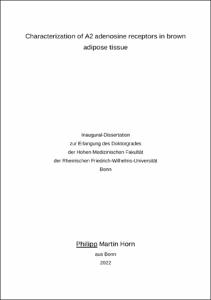Horn, Philipp Martin: Characterisation of A2 adenosine receptors in brown adipose tissue. - , 2022. - Dissertation, Rheinische Friedrich-Wilhelms-Universität Bonn.
Online-Ausgabe in bonndoc: https://nbn-resolving.org/urn:nbn:de:hbz:5-65293
Online-Ausgabe in bonndoc: https://nbn-resolving.org/urn:nbn:de:hbz:5-65293
@phdthesis{handle:20.500.11811/9622,
urn: https://nbn-resolving.org/urn:nbn:de:hbz:5-65293,
author = {{Philipp Martin Horn}},
title = {Characterisation of A2 adenosine receptors in brown adipose tissue},
school = {Rheinische Friedrich-Wilhelms-Universität Bonn},
year = 2022,
month = feb,
note = {Pandemic obesity and its associated diseases like type 2 diabetes, coronary heart failures, stroke and cancer has become one of the leading worldwide health problems. Obesity is characterized for the excessive abundance of white adipose tissue (WAT), which main function is to store energy in the form of fat. Brown adipose tissue (BAT) on the other hand consumes energy through non-shivering thermogenesis. Since it was shown that adult humans possess metabolic active BAT in 2009, pharmacological activation of brown fat cells promises to be a new strategy in order to treat obesity. BAT function is stimulated by neurons of the sympathetic nervous system. ATP is a co-transmitter released together with NE from sympathetic nerves, adenosine is a breakdown product of ATP.
In my thesis, I was not only able to show that adenosine stimulates BA function, but also that lipolysis is increased by adenosine while stimulating the cells with NE shortly before. This could indicate a possible co-stimulation of BAT with NE and adenosine by the sympathetic nervous system and open up new pharmacological approaches for the activation of BAT. First, however, the question arises through which of the adenosine receptors this effect is mediated. I could show that all adenosine receptor subtypes are expressed in BA, the A2B receptor being the most abundant. The A2A receptor is strongly upregulated during differentiation. A2A and A2B receptor agonists and antagonists do not have a significant effect on the differentiation of brown adipocytes. However, stimulation of A2A and A2B using specific agonists activates BA with significant increase of intracellular cAMP and elevated lipolysis. Over-expression of the A2A receptor, without direct stimulation with an agonist, lead to an increased differentiation of brown adipocytes. I could also show a stimulating effect on BA function by the over-expression of the two receptors.
This data suggests an important role of the A2A and A2B receptor for the activation of BA function. Especially the A2A receptor may become an important pharmacological target in the therapy of obesity as it has been shown to be highly abundant in human BAT. As adenosine receptors are not only expressed on fat cells, but many important tissues of the human body, potential side effects of a therapy with adenosine or specific adenosine receptor agonists remain a problem to be solved.},
url = {https://hdl.handle.net/20.500.11811/9622}
}
urn: https://nbn-resolving.org/urn:nbn:de:hbz:5-65293,
author = {{Philipp Martin Horn}},
title = {Characterisation of A2 adenosine receptors in brown adipose tissue},
school = {Rheinische Friedrich-Wilhelms-Universität Bonn},
year = 2022,
month = feb,
note = {Pandemic obesity and its associated diseases like type 2 diabetes, coronary heart failures, stroke and cancer has become one of the leading worldwide health problems. Obesity is characterized for the excessive abundance of white adipose tissue (WAT), which main function is to store energy in the form of fat. Brown adipose tissue (BAT) on the other hand consumes energy through non-shivering thermogenesis. Since it was shown that adult humans possess metabolic active BAT in 2009, pharmacological activation of brown fat cells promises to be a new strategy in order to treat obesity. BAT function is stimulated by neurons of the sympathetic nervous system. ATP is a co-transmitter released together with NE from sympathetic nerves, adenosine is a breakdown product of ATP.
In my thesis, I was not only able to show that adenosine stimulates BA function, but also that lipolysis is increased by adenosine while stimulating the cells with NE shortly before. This could indicate a possible co-stimulation of BAT with NE and adenosine by the sympathetic nervous system and open up new pharmacological approaches for the activation of BAT. First, however, the question arises through which of the adenosine receptors this effect is mediated. I could show that all adenosine receptor subtypes are expressed in BA, the A2B receptor being the most abundant. The A2A receptor is strongly upregulated during differentiation. A2A and A2B receptor agonists and antagonists do not have a significant effect on the differentiation of brown adipocytes. However, stimulation of A2A and A2B using specific agonists activates BA with significant increase of intracellular cAMP and elevated lipolysis. Over-expression of the A2A receptor, without direct stimulation with an agonist, lead to an increased differentiation of brown adipocytes. I could also show a stimulating effect on BA function by the over-expression of the two receptors.
This data suggests an important role of the A2A and A2B receptor for the activation of BA function. Especially the A2A receptor may become an important pharmacological target in the therapy of obesity as it has been shown to be highly abundant in human BAT. As adenosine receptors are not only expressed on fat cells, but many important tissues of the human body, potential side effects of a therapy with adenosine or specific adenosine receptor agonists remain a problem to be solved.},
url = {https://hdl.handle.net/20.500.11811/9622}
}






